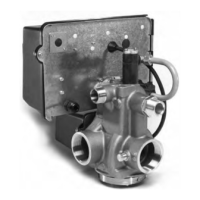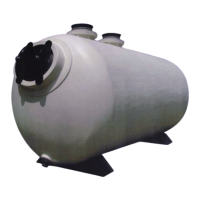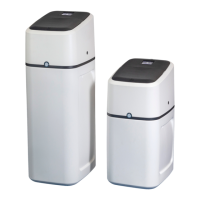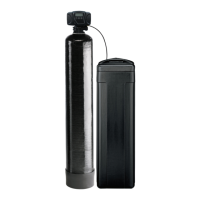Installer Manual Fleck 2910 - NXT - System sizing
Ref. MKT-IM-002 / B - 23.05.2018 25 / 114
4.2.2. Determining the required volume of resin
When sizing a softener, make sure that the volume of resin in the tank (bed volume) will be sufficient
so that even when the peak flow rate is reached, the velocity is still between the above values
depending on the hardness. When sizing a softener, always choose the resin volume and tank size
based on the peak flow rate but not on the nominal flow rate.
Note
Sizing on the nominal flow rate without taking the peak flow rate into account would result
in choosing smaller tank size and resin volume, and may lead in severe hardness leakage
during the service cycle when the peak flow is reached.
The maximum softened water flow rate that a softener can produce is given by the following formula:
Knowing this required volume of resin, it is possible now to determine the tank you need. Note that at
least a third of the total volume of the tank must be kept as free space so that the bed expansion
during backwash is sufficient to ensure correct cleaning of the resin.
4.2.3. Resin exchange capacity and capacity of the unit
The resin exchange capacity and capacity of the unit are two different things that should not be
confused. The resin exchange capacity is the amount of Ca
2+
and Mg
2+
that can be retained by 1 litre
of resin, which will depend on the resin type and salt dosage, whereas the capacity of the unit is the
capacity of the system, which will depend on the volume of resin and resin exchange capacity.
Knowing the required volume of resin, you can determine the exchange capacity of the unit. The
capacity of the unit can be expressed in different ways:
• the mass capacity, which corresponds to the weight in equivalent CaCO
3
that can be fixed on the
resin, expressed in kg as CaCO
3
;
• the volume capacity, which represents the maximum amount of water that can be treated
between 2 regenerations. This last capacity takes into account the hardness of the water to be
treated and is expressed in m
3
or litres;
• the combined capacity, which represents the volume of water that could be treated between 2
regenerations if the inlet hardness is 1 °f or °dH. This capacity is expressed in °f.m
3
or °dH.m
3
.
The resin exchange capacity will depend on the amount of salt to be injected into the resin bed during
the regeneration. This amount of salt is given in grams per litre of resin. The next table is showing the
resin exchange capacity in function of the amount of salt for a system with standard efficiency
regeneration.
Q
service max
= Fs
service
x BV
with:
Q
service max
: service flow rate [m
3
/h]
Fs
service
: service velocity [BV/h]
BV: bed volume of resin [m
3
]

